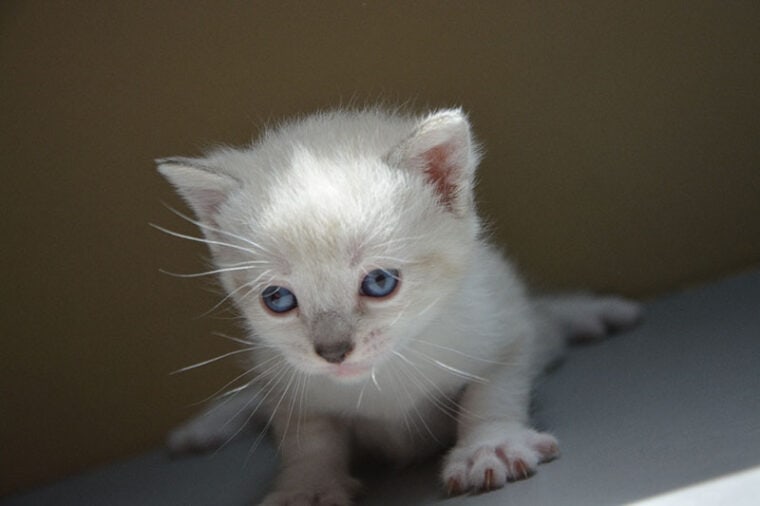
Raising and caring for young kittens can be an extremely rewarding experience. However, it requires a lot of preparation for any sort of issues that may occur throughout a kitten’s growth and development. Swimmer Syndrome is one health condition to be aware of, as it affects kittens less than a month after their birth.
Swimmer Syndrome can completely immobilize a kitten, but it’s treatable, and many kittens have a very positive prognosis after receiving physical therapy. Acting quickly at the first signs of Swimmer Syndrome can be life-changing for a kitten.
What Is Swimmer Syndrome?
Swimmer Syndrome is an uncommon developmental issue that mostly affects puppies, but there are rare cases of it occurring in kittens. Swimmer Syndrome is a congenital condition that affects a kitten’s mobility and makes it very difficult for them to walk. They have difficulty controlling their limbs, and they may not be able to stand on their own.
Signs of Swimmer Syndrome typically appear between the first 15-20 days of a kitten’s life. Kittens can usually start to walk within 10-15 days after birth. However, the condition often remains undetected until kittens reach about 3 weeks old, when they can walk on their own confidently. Experienced cat breeders may be able to notice the signs at a much earlier age.
Swimmer Syndrome is a broad term for kittens with ambulatory issues due to malformed limbs. Treatment options will vary depending on the severity of the condition and which muscles are affected by it.
What Are the Signs of Swimmer Syndrome?
The most common sign of Swimmer Syndrome is the lack of control of the hind legs. Kittens with Swimmer Syndrome usually have their hind legs splayed out, like frog legs. They’ll usually try to walk around with their front legs and have their hind legs dragging behind them. This action makes them look like they’re swimming.
It’s important to be mindful of Swimmer Syndrome when a kitten reaches about 10 days old and when it starts to walk. It’ll take kittens days to get used to walking, but they’ll usually be walking normally by the time they’re 3 weeks old. You can examine the kitten’s gait around this time to see if it’s normal. If you notice that its back limbs are splayed outwards and they have difficulty walking straight or walking at all, there’s a good chance that it has Swimmer Syndrome.
What Are the Causes of Swimmer Syndrome?

It’s unclear as to how a kitten develops Swimmer Syndrome, but most specialists believe that there is a genetic component. Since it’s a pretty rare condition in cats, there isn’t much research or data related to it. However, there have been cases of Swimmer Syndrome in a litter of cats born from a Devon Rex and a crossbreed cat. In most cases, only one kitten in a litter will develop Swimmer Syndrome. However, it’s not impossible for an entire litter to have it.
Some researchers also believe that diet may trigger Swimmer Syndrome. Excessive protein in the pregnant cat’s diet may put her kittens at risk of malformed limb muscles. However, more research needs to be conducted to further investigate this possible correlation.
There are more cases of Swimmer Syndrome in brachycephalic dog breeds, but there aren’t enough cases in cats that can determine that brachycephalic cat breeds are at higher risk of being born with Swimmer Syndrome.
Since it’s difficult to determine the exact cause of Swimmer Syndrome, it’s best to keep providing sufficient prenatal care for cats and feed them the right kind of diet. You can also monitor your kittens’ development as soon as they’re born to look for early signs of Swimmer Syndrome.
How Do I Care for a Kitten with Swimmer Syndrome?
Kittens with Swimmer Syndrome can receive treatment, and full recovery is possible. It’s best to consult your veterinarian to receive a proper diagnosis and the most appropriate treatment protocol. Recovery often consists of realigning the limbs to the correct position and physical therapy to strengthen the muscles.
1. Sling Bandages
The most common form of treatment is wrapping sling bandages around the kitten’s pelvic limbs. These bandages will act as braces that help align a kitten’s limbs in the correct position. The bandages will have to be removed and replaced periodically to prevent skin infections.
2. Physical Therapy
Kittens will also have to engage in physical therapy and may need your assistance a couple of times a day to help them walk and strengthen their legs. Some of the best times to do physical therapy is right after you remove bandages to adjust or replace them.
Kittens usually need to start by walking on surfaces with a lot of traction. They can move on to walking on more challenging surfaces as they progress. At the guidance of your veterinarian, you can also try lifting the kitten’s front legs slightly to add more weight to its hind legs. This can help strengthen the back limbs and the core.
3. Supplements

Veterinarians may prescribe vitamin B and vitamin D3 supplements to help nourish their development. Kittens may also benefit from warm water compresses. Gentle heat can help increase oxygen delivery in the muscles and relax stiff joints. Massages can also help relax and strengthen limb muscles.
Caring for kittens with Swimmer Syndrome is intensive as so much development happens during this life stage. Every day counts, and full recovery is possible for many kittens with consistent physical therapy and proper bandaging. Consistent treatment can yield significant positive results in just a week.
Frequently Asked Questions (FAQs)
Is Swimmer Syndrome a neurological disorder?
Swimmer Syndrome appears to be a muscular disorder rather than a neurological disorder. Kittens with Swimmer Syndrome have trouble walking due to weak muscles and malformed joints. A neurological condition that affects a kitten’s mobility at birth is Cerebellar Hypoplasia. This disorder happens when a pregnant cat passes the feline distemper virus to her litter. Signs of Cerebellar Hypoplasia include jerky movements, incoordination, and difficulty with balance.
How long does it take to correct Swimmer Syndrome?
Most kittens can recover full or nearly full mobility with proper treatment. Recovery usually takes 2-4 weeks, and treatment must be consistent. You’ll have to constantly monitor your kitten’s progress, adjust and replace bandages or slings, administer any medication or supplements, and help your kitten engage in physical therapy.
Conclusion
Swimmer Syndrome is a serious condition in kittens that can severely affect their mobility and quality of life. Fortunately, it is treatable, and kittens that receive treatment and therapy can grow to become healthy cats that live normal lives. So, if you suspect Swimmer Syndrome in a young kitten, make sure to act quickly to increase the chances of successful rehabilitation.
Featured Image Credit: JumpStory






